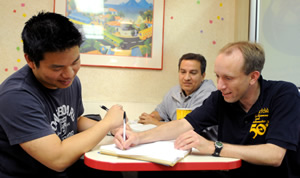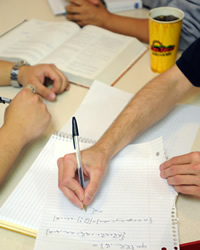Math Made Personal
Award-Winning Teacher Relentlessly Probes for Strengths
March 31, 2009
By Russ L. Hudson

Caption: Scott A. Annin receiving the Carol T. Barnes Excellence in Teaching Award from President Milton A. Gordon
It’s 6:56 p.m. and Scott A. Annin, associate professor of mathematics, sits in the back corner booth at the Del Taco at Commonwealth Avenue and State College Boulevard. At the moment, he is bent over a book, untouched food at his elbow. The food will stay untouched for an hour.
It is the start of a 7-10 p.m. Tuesday night routine the mathematician has repeated for years. In a few minutes, Annin will start demonstrating yet again why he won the university’s 2008 Carol Barnes Excellence in Teaching Award and the 2009 Henry L. Adler Award for Distinuished Teaching from the Mathematical Association of America.
Annin arranges his office hours this way so room and time for students are less limited than they would be on campus. It cuts into his personal time, but the faculty member sees it as a two-way transaction: the students get additional help with math concepts and their questions help him refine how he teaches in the classroom. And, he says, “meeting at an informal place like Del Taco lets the students see my human side.”

Students Andy Yang, left, and Misael Saucedo get some math tutoring from Scott Annin, right, at the local Del Taco on a recent Tuesday night. Photo by Kelly Lacefield
Tutoring in Session
By 7:25 p.m., students fill all the tables across the back of Del Taco. The students range from those in a required business calculus class to those in complex analysis, which is so advanced that most of the few students who take it plan careers as mathematicians or teachers of advanced mathematics.
Annin tirelessly answers questions and smiles frequently. Words and phrases foreign to most listeners float from the many conversations: “Cauchy-Riemann equation,” “testing if a complex function is differentiable,” “you need to use 2.71828,” “the u of xy and the v of xy.”
He is always positive, never saying “no” or “wrong,” and he relentlessly probes for strengths.
When he finds a strength, he exploits it; matching students’ strengths with other students’ questions, saying, “she can help you, she’s great at that.” They become teachers, as well as students, and each helps quietly and with smiles … like Annin.
Often he answers a question with another question that starts a train of thought leading students to their own answers.
“Dr. Annin, I got stopped here, I’m not sure where to go.”
“I see your approach here, and you started with the speed of the train and the weight of its load. That’s a good approach. Why did you take it?”
“I figured I needed to know how much work the train was doing.”

Math tutoring sessions are augmented by refreshments. Photos by Kelly Lacefield
“So what would you do next?”
Within seconds, clarity dawns and the student sees the path to the solution. Annin caps it with “your approach was good! You were going to get the answer all along!”
Later: “I knew at a very early age that I wanted to become a teacher,” Annin said. “It is incredibly rewarding to see myself making a difference in people’s lives, and I don’t just mean increasing their knowledge of mathematics. I think I would enjoy teaching any subject, I just happen to be well qualified to do this in mathematics.
“I have chosen to use that gift to inspire others, to be a role model for finding enthusiasm in what you do. It doesn’t necessarily mean that things are going to be easy, but … when students see me working hard to help them, they naturally tend to give back that effort. They become better students without even realizing it.”
The mathematician said he is only doing for others what his mentors did for him.
Inspiration
“I have had several inspirational teachers and mentors through the years. My 7th- to 10th-grade math teacher, Leona Penner, at Lincoln East Junior-Senior High School in Nebraska, made us work so hard every day,” Annin explained. “I learned from her that the best teachers are not the easy teachers, but the ones who challenge us.
“Professor John Meakin in the math department at the University of Nebraska was my main mentor while I was an undergraduate. Not only was he a phenomenal teacher from whom I derived many secrets of good teaching, he also pulled me aside to work with him,” said Annin. “The time and attention he selflessly gave impressed upon me the great value of being connected with people on a personal level.”
Cal State Fullerton alumnus Alex Lechuga got his bachelor’s degree in math in 2005 and his master’s in 2007, and now is Annin's colleague. The second-year lecturer teaches “Short Course in Calculus” this year, a course very similar to Annin’s business calculus course.
“He was by far one of my favorite teachers at Cal State Fullerton. So much so that after my first semester I tried to work around my schedule to take his classes. He gave me such a strong mathematical background that it made the transition to harder classes much smoother,” Lechuga said. Even when he didn’t have Annin for a class, Lechuga said he could ask for help, something Annin did for many students.
“Now, as I start my own teaching career, I look back and try to analyze what made him such a great teacher,” Lechuga said. He concluded that it came down to the clarity of Annin’s lectures, his willingness and desire to help and his patience in doing so. “These are the characteristics I strive to project to my students so their experiences in math are a enjoyable as mine were.”
Kyle Marx, a senior math major in the Complex Analysis class, might one day become another of that small group who were Annin’s students and then his colleagues. Marx said having Annin as a teacher changed his goals. He was considering a career as a high school math teacher, “but Dr. Annin took me aside. He said he’d seen my potential to go on to more advanced mathematics and he wanted a talk with me. He thought I should keep going in my education. Now I’m going to go for a doctorate, then I think I’d like to become a professor, and I want to pursue number theory.”
There are other good math teachers who have taught him a lot, Marx said, but Annin “talks to each of us at least once a semester, gets to know us. He takes a personal interest. I like that. It isn’t just about the math.”
At Del Taco, some students talk behind Annin’s back as soon as he walks away. Whenever there is a small break in the questions, Annin scans the other tables and, if he sees frowns, sidles over and quietly asks if there is something he can do.
During one of those strolls away from his table, two business calculus students had this to say.
“I don’t know, if I wasn’t in his class, I might be failing,” said sophomore Efrain Montellano. “Or, anyway, struggling.”
“When he walks into class, he’s so high-energy, so enthusiastic,” said freshman Alexandra Silieazar.
“What I like is how he tells what he’s going to teach,” explained Montellano. “Why it’s important, how we’re going to use it, then says, ‘OK, let’s learn it!’”
“Yeah!” agreed Silieazar.
As Annin returns to his table, they return to their calculus. The evening, and the two-way teaching, continued for another Tuesday at Del Taco.

